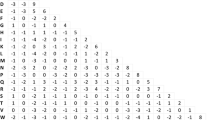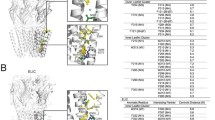Abstract
Class A G-protein-coupled receptors (GPCRs) constitute a large family of transmembrane receptors. Helical distortions play a major role in the overall fold of these receptors. Most are related to conserved proline residues. However, in transmembrane helix 2, the proline pattern is not conserved, and when present, proline may be located at position 2.58, 2.59, or 2.60. Sequence analysis, three-dimensional data mining, and molecular modeling were undertaken to investigate the origin of this unusual pattern. Taken together, the data strongly support the assumption that an indel led to two structural motifs for helix 2: a bulged structure in P2.59 and P2.60 receptors and a “typical” proline kink in P2.58 receptors. The proline pattern of helix 2 can be used as an evolutionary marker and helps to trace the molecular evolution of class A GPCRs. Two indel events yielding functional receptors occurred independently. One indel arose very early in GPCR evolution, in a bilaterian ancestor, before the protostome-deuterostome divergence. This indel led to the split between the P2.58 somatostatin/opioid receptors and other peptide receptors with the P2.59 pattern. A second indel also occurred in insect opsins and corresponds to a deletion. Subfamilies with proline at position 2.59 or no proline expanded earlier, whereas P2.60 receptors remained marginal throughout evolution. P2.58 receptors underwent rapid expansion in vertebrates with the development of the chemokine and purinergic receptor subfamilies from somatostatin/opioid-related ancestors.








Similar content being viewed by others
References
Attwood TK, Findlay JB (1994) Fingerprinting G-protein-coupled receptors. Protein Eng 7:195–203
Ballesteros JA, Shi L, Javitch JA (2001) Structural mimicry in G protein-coupled receptors: implications of the high-resolution structure of rhodopsin for structure-function analysis of rhodopsin-like receptors. Mol Pharmacol 60:1–19
Berger EA, Murphy PM, Farber JM (1999) Chemokine receptors as HIV-1 coreceptors: roles in viral entry, tropism, and disease. Annu Rev Immunol 17:657–700
Blanpain C, Lee B, Vakili J, Doranz BJ, Govaerts C, Migeotte I, Sharron M, Dupriez V, Vassart G, Doms RW, Parmentier M (1999) Extracellular cysteines of CCR5 are required for chemokine binding, but dispensable for HIV-1 coreceptor activity. J Biol Chem 274:18902–18908
Brandstrom M, Ellegren H (2007) The genomic landscape of short insertion and deletion polymorphisms in the chicken (Gallus gallus) genome: a high frequency of deletions in tandem duplicates. Genetics 176:1691–1701
Brooks BR, Bruccoleri RE, Olafson BD, States DJ, Swaminathan S, Karplus M (1983) CHARMM: a program for macromolecular energy, minimization, and dynamics calculations. J Comp Chem 4:187–217
Cartailler JP, Luecke H (2004) Structural and functional characterization of pi bulges and other short intrahelical deformations. Structure 12:133–144
Chang MS, Benner SA (2004) Empirical analysis of protein insertions and deletions determining parameters for the correct placement of gaps in protein sequence alignments. J Mol Biol 341:617–631
Cherezov V, Rosenbaum DM, Hanson MA, Rasmussen SG, Thian FS, Kobilka TS, Choi HJ, Kuhn P, Weis WI, Kobilka BK, Stevens RC (2007) High-resolution crystal structure of an engineered human beta2-adrenergic G protein-coupled receptor. Science 318:1258–1265
Deisenhofer J, Epp O, Sinning I, Michel H (1995) Crystallographic refinement at 2.3 A resolution and refined model of the photosynthetic reaction centre from Rhodopseudomonas viridis. J Mol Biol 246:429–457
de la Chaux N, Messer PW, Arndt PF (2007) DNA indels in coding regions reveal selective constraints on protein evolution in the human lineage. BMC Evol Biol 7:191
Deville J, Rey J, Chabbert M (2008) Comprehensive analysis of the helix-X-helix motif in soluble proteins. Proteins 72:115–135
Eddy SR (1998) Profile hidden Markov models. Bioinformatics 14:755–763
Fredriksson R, Schioth HB (2005) The repertoire of G-protein-coupled receptors in fully sequenced genomes. Mol Pharmacol 67:1414–1425
Fredriksson R, Lagerstrom MC, Lundin LG, Schioth HB (2003) The G-protein-coupled receptors in the human genome form five main families. Phylogenetic analysis, paralogon groups, and fingerprints. Mol Pharmacol 63:1256–1272
Gether U (2000) Uncovering molecular mechanisms involved in activation of G protein-coupled receptors. Endocr Rev 21:90–113
Govaerts C, Blanpain C, Deupi X, Ballet S, Ballesteros JA, Wodak SJ, Vassart G, Pardo L, Parmentier M (2001) The TXP motif in the second transmembrane helix of CCR5. A structural determinant of chemokine-induced activation. J Biol Chem 276:13217–13225
Govaerts C, Bondue A, Springael JY, Olivella M, Deupi X, Le Poul E, Wodak SJ, Parmentier M, Pardo L, Blanpain C (2003) Activation of CCR5 by chemokines involves an aromatic cluster between transmembrane helices 2 and 3. J Biol Chem 278:1892–1903
Halls ML, van der Westhuizen ET, Bathgate RA, Summers RJ (2007) Relaxin family peptide receptors—former orphans reunite with their parent ligands to activate multiple signalling pathways. Br J Pharmacol 150:677–691
Holm L, Sander C (1998) Removing near-neighbour redundancy from large protein sequence collections. Bioinformatics 14:423–429
Jacoby E, Bouhelal R, Gerspacher M, Seuwen K (2006) The 7 TM G-protein-coupled receptor target family. ChemMedChem 1:761–782
Joost P, Methner A (2002) Phylogenetic analysis of 277 human G-protein-coupled receptors as a tool for the prediction of orphan receptor ligands. Genome Biol 3:RESEARCH0063
Kavanaugh JS, Moo-Penn WF, Arnone A (1993) Accommodation of insertions in helices: the mutation in hemoglobin Catonsville (Pro 37 alpha-Glu-Thr 38 alpha) generates a 3(10)→alpha bulge. Biochemistry 32:2509–2513
Keefe LJ, Sondek J, Shortle D, Lattman EE (1993) The alpha aneurism: a structural motif revealed in an insertion mutant of staphylococcal nuclease. Proc Natl Acad Sci USA 90:3275–3279
Kleywegt GJ (1999) Recognition of spatial motifs in protein structures. J Mol Biol 285:1887–1897
Kolakowski LF Jr (1994) GCRDb: a G-protein-coupled receptor database. Receptors Channels 2:1–7
Kreienkamp HJ, Larusson HJ, Witte I, Roeder T, Birgul N, Honck HH, Harder S, Ellinghausen G, Buck F, Richter D (2002) Functional annotation of two orphan G-protein-coupled receptors, Drostar1 and -2, from Drosophila melanogaster and their ligands by reverse pharmacology. J Biol Chem 277:39937–39943
Kumar S, Tamura K, Nei M (2004) MEGA3: integrated software for Molecular Evolutionary Genetics Analysis and sequence alignment. Brief Bioinform 5:150–163
Lagerstrom MC, Schioth HB (2008) Structural diversity of G protein-coupled receptors and significance for drug discovery. Nat Rev Drug Discov 7:339–357
Lander ES, Linton LM, Birren B, Nusbaum C, Zody MC, Baldwin J, Devon K, Dewar K, Doyle M, FitzHugh W et al (2001) Initial sequencing and analysis of the human genome. Nature 409:860–921
Li J, Edwards PC, Burghammer M, Villa C, Schertler GF (2004) Structure of bovine rhodopsin in a trigonal crystal form. J Mol Biol 343:1409–1438
Melillo D, Sfyroera G, De Santis R, Graziano R, Marino R, Lambris JD, Pinto MR (2006) First identification of a chemotactic receptor in an invertebrate species: structural and functional characterization of Ciona intestinalis C3a receptor. J Immunol 177:4132–4140
Nakamichi H, Okada T (2006) Local peptide movement in the photoreaction intermediate of rhodopsin. Proc Natl Acad Sci USA 103:12729–12734
Okada T, Fujiyoshi Y, Silow M, Navarro J, Landau EM, Shichida Y (2002) Functional role of internal water molecules in rhodopsin revealed by X-ray crystallography. Proc Natl Acad Sci USA 99:5982–5987
Okada T, Sugihara M, Bondar AN, Elstner M, Entel P, Buss V (2004) The retinal conformation and its environment in rhodopsin in light of a new 2.2 A crystal structure. J Mol Biol 342:571–583
Palczewski K, Kumasaka T, Hori T, Behnke CA, Motoshima H, Fox BA, Le Trong I, Teller DC, Okada T, Stenkamp RE, Yamamoto M, Miyano M (2000) Crystal structure of rhodopsin: a G protein-coupled receptor. Science 289:739–745
Reis RI, Santos EL, Pesquero JB, Oliveira L, Schanstra JP, Bascands JL, Pecher C, Paiva AC, Costa-Neto CM (2007) Participation of transmembrane proline 82 in angiotensin II AT1 receptor signal transduction. Regul Pept 140:32–36
Sali A, Blundell TL (1993) Comparative protein modelling by satisfaction of spatial restraints. J Mol Biol 234:779–815
Sarma GN, Nickel C, Rahlfs S, Fischer M, Becker K, Karplus PA (2005) Crystal structure of a novel Plasmodium falciparum 1-Cys peroxiredoxin. J Mol Biol 346:1021–1034
Sealfon SC, Chi L, Ebersole BJ, Rodic V, Zhang D, Ballesteros JA, Weinstein H (1995) Related contribution of specific helix 2 and 7 residues to conformational activation of the serotonin 5-HT2A receptor. J Biol Chem 270:16683–16688
Surgand JS, Rodrigo J, Kellenberger E, Rognan D (2006) A chemogenomic analysis of the transmembrane binding cavity of human G-protein-coupled receptors. Proteins 62:509–538
Taylor MS, Ponting CP, Copley RR (2004) Occurrence and consequences of coding sequence insertions and deletions in mammalian genomes. Genome Res 14:555–566
Teller DC, Okada T, Behnke CA, Palczewski K, Stenkamp RE (2001) Advances in determination of a high-resolution three-dimensional structure of rhodopsin, a model of G-protein-coupled receptors (GPCRs). Biochemistry 40:7761–7772
Thompson JD, Higgins DG, Gibson TJ (1994) CLUSTAL W: improving the sensitivity of progressive multiple sequence alignment through sequence weighting, position-specific gap penalties and weight matrix choice. Nucleic Acids Res 22:4673–4680
Vassilatis DK, Hohmann JG, Zeng H, Li F, Ranchalis JE, Mortrud MT, Brown A, Rodriguez SS, Weller JR, Wright AC, Bergmann JE, Gaitanaris GA (2003) The G protein-coupled receptor repertoires of human and mouse. Proc Natl Acad Sci USA 100:4903–4908
Venter JC, Adams MD, Myers EW, Li PW, Mural RJ, Sutton GG, Smith HO, Yandell M, Evans CA, Holt RA et al (2001) The sequence of the human genome. Science 291:1304–1351
Weaver TM (2000) The pi-helix translates structure into function. Protein Sci 9:201–206
Yohannan S, Faham S, Yang D, Whitelegge JP, Bowie JU (2004) The evolution of transmembrane helix kinks and the structural diversity of G protein-coupled receptors. Proc Natl Acad Sci USA 101:959–963
Acknowledgments
We thank NEC Computer Services SARL (Angers, France) for the kind provision of a multiprocessor server. We thank D. Thybert and M. Moreau for their contribution to the GPCR sequence analysis. J.D. was supported by fellowships from INSERM—Région des Pays-de-la-Loire and from the Association pour la Recherche sur le Cancer (ARC). J.R. was supported by a fellowship from CNRS.
Author information
Authors and Affiliations
Corresponding author
Electronic supplementary material
Below is the link to the electronic supplementary material.
Rights and permissions
About this article
Cite this article
Devillé, J., Rey, J. & Chabbert, M. An Indel in Transmembrane Helix 2 Helps to Trace the Molecular Evolution of Class A G-Protein-Coupled Receptors. J Mol Evol 68, 475–489 (2009). https://doi.org/10.1007/s00239-009-9214-9
Received:
Revised:
Accepted:
Published:
Issue Date:
DOI: https://doi.org/10.1007/s00239-009-9214-9




